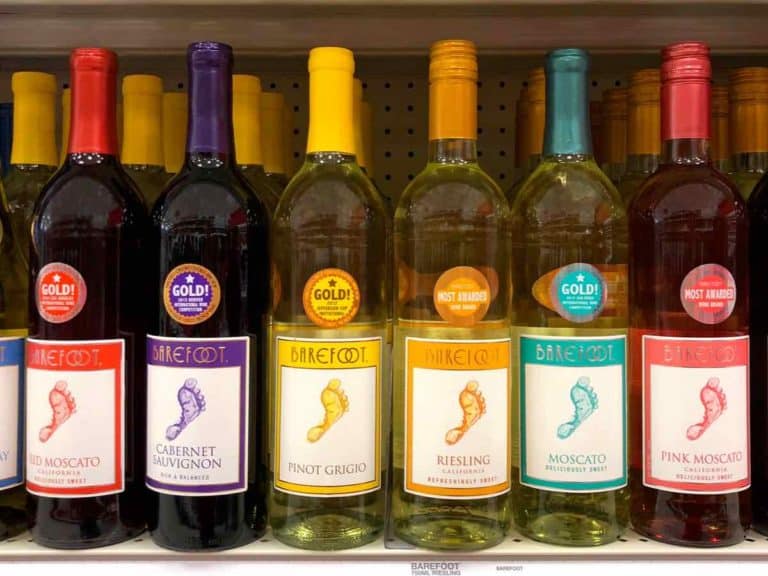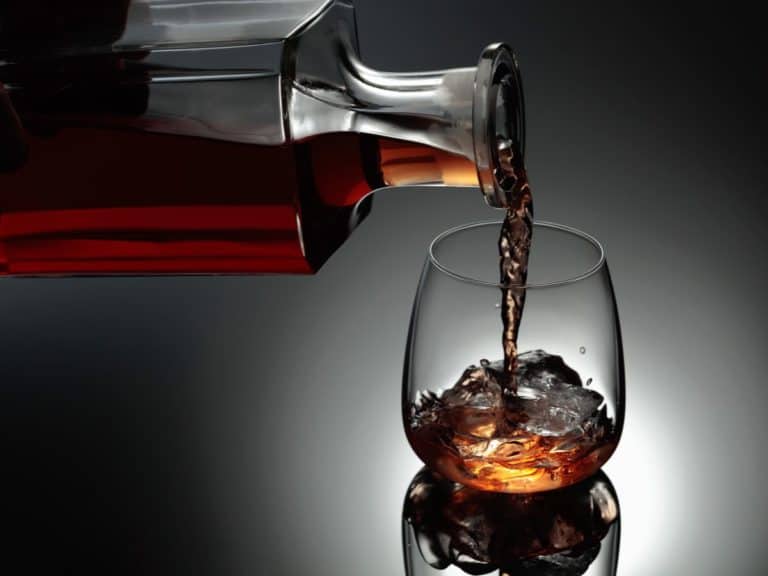Blush vs. Rose Wines Breakdown
When you hear wine enthusiasts talking about blush wine or rosé, they could be talking about any number of pink wines. Often people will incorrectly use these two terms interchangeably.
A rosé wine might be a blush wine, but a blush wine isn’t necessarily a rosé wine. Blush wine can refer to either a traditional rosé wine or a house wine mixture of both red and white wine. Blush wine and rosé are similar in flavor and aroma.
Blush wines and rosé wines both have a lot to offer wine hobbyists, but it helps to know about the subtle distinctions between them before you start doing tastings of these pink drinks. Read on to learn more about the differences and similarities between rosé and blush wine.

Are Blush Wine and Rosé the Same?
Even though some people may use blush wine and rosé wine as synonyms, these two wine styles are slightly different. A “blush wine” refers to any pink wine with a flavor profile between red and white, while a rosé wine is a specific style of wine where the wine is allowed to stay in contact with the grape skins of red grapes until a slight coloring is achieved.
A blush wine doesn’t necessarily mean a rosé wine. Blush wine can also be created by blending white wine and red wine together. This means that rosé can be a blush wine, but a blush wine isn’t always a rosé.
How Is Rosé Different Than Blush?
Other than how they’re processed, another major difference between rosé and blush is in their scope. Blush wines are often produced as semi-sweet mass-market wines produced in very large quantities and are designed to be as consistent in flavor and aroma as possible from one batch to another.
Most blush wines have a pale or peachy pink coloring.
In contrast, rosé wines are artisan wines that can come in various colors, from grayish-pink to dark ruby or salmon pink, depending on the grape varietals used and the amount of time the wine is left in contact with the grape skins.
The Origins of Rosé Wine vs. the Origins of Blush Wine
Rosé wine and blush wine look similar, but they have different origins.
Mass-marketed blush wines such as White Zinfandel and blended house wines mixed from red and wine have been around for a long time, but they seriously became a popular drink in North America in the latter part of the 20th century.
The most popular type of sweet blush wine in the United States, White Zinfandel, wasn’t even invented until the late 1970s.
Rosé wines have a long history going back much further than blush. Rosé wines are one of the oldest varieties of wine ever made and records of this pink drink date back to the ancient Greeks and Romans.
For this reason, rosé wines are strongly associated with the Mediterranean region. These wines are often paired with French, Spanish, and Italian dishes.
What Kind of Grape Varietals Are Used in Blush Wines?
There are several different grape varietals traditionally used in blush wines. Note that the grapes used in blush have to be red since it’s the color of the grape skins that gives blush it’s pink coloring.
Here are some of the most popular grapes used for making blush wine (Source: LoveToKnow):
- White Zinfandel: White Zinfandel is the most popular blush wine consumed in North America, and it is created using red-skinned Zinfandel grapes. White Zinfandel has flavors of strawberry and citrus.
- White Merlot: Merlot grapes are dark blue-black grapes used for blending in blush wines and creating varietals. Merlot wines have a berry-dominant flavor with notes of raspberry tart and honey.
- White Grenache: White Grenache grapes give blush wines bright, acidic, fruity flavors and aromas such as watermelon, raspberry, lemonade, and cucumber.
Though these three types of grapes have white in the name, all three of them are dark-colored grapes. This allows them to make both blush wines and rosé varietals.
Why Is White Zinfandel Blush?
If you’ve never had a blush wine like White Zinfandel before, you might expect this wine to be white! However, the name of this popular pink-colored wine isn’t about the hue of the wine itself.
When White Zinfandel was invented, the vintage was originally called Oeil de Perdrix by the winemakers at Sutter Home. It was originally named after a Swiss rosé wine whose name in French means “the eye of the partridge.”
However, due to American wine manufacturing laws, Sutter Home was required to label the wine with an English name. So Sutter Home’s Oeil de Perdrix was renamed White Zinfandel, and the rest is winemaking history. (Source: Barefoot Wine)
What Kind of Grape Varietals Are Used in Rosé Wines?
Many of the same grapes used for making blush wines are also used to make traditional rosé wines. Along with the grape varietals listed in the section above, here are a few other kinds of grape varietals used for making rosé wines instead:
- Tempranillo: Unlike blush wines, many varieties of rosé lean towards the crisper side, and Tempranillo is no exception. This full-bodied rosé still has mellow fruit-forward aromas and flavor notes even though the overall palate of the wine is dry.
- Provence: The rosé wines made in Provence, France, are among the driest rosé wines available on the European market. Compared to some of the more subtle and complex flavor profiles found in rosé wines, Provence rosé has a simple flavor that is sharp and light compared to the blush wines found in America.
- Cabernet Sauvignon: Many rosé wines are more dry and acidic than blush wines. Cabernet Sauvignon is a grape varietal with a more acidic profile than Cabernet grapes, making them a good match for rosé and blush wines.
- Tavel: Tavel grapes are a grape varietal that is grown specifically for use in making rosé. Tavel is a good middle-of-the-road rosé which is considered to be versatile for pairing with different foods.
These are only a few of the many types of grapes used to make rosé wines. Since rosé can be created from any red-skinned grape, most red grape varietals have some variation of rosé available that is made from them. The final flavor of a rosé wine depends on several variables:
- What type of grapes were used? The grapes used to make rosé vary wildly in flavor and aroma, which is why rosé wines can run the gamut from very dry to very sweet. Whether you’re looking for a dessert wine or a tart, chilled wine for a lazy afternoon, there is a variety of rosé available that would be perfect for the occasion.
- How was the wine processed? There are a few different methods that are used to process rosé wines that can affect how they turn out. Rosé wines are created through three different methods: skin contact (vin gris), the saignée method, and blending. Processing methods affect flavor, coloration, and the number of tannins left in the wine.
- What secondary spices were added during processing? Many semi-dry and off-dry rosé wines are treated with secondary spices to add complexity and depth to their flavors. Common spices include cinnamon, cloves, and allspice.
You can put two rosé wines next to each other from different ends of the flavor spectrum for this wine style, and they may taste almost nothing alike.
This is why it’s important to try a range of different rosé and blush wines before you write them off as too sweet or simple. Chances are you haven’t experienced everything that rosé has to offer.

How Is Rosé Wine Made?
Rosé wine is created using two primary methods: vin gris and the saignée method. Here’s how these two winemaking processes differ:
- Vin gris: Vin gris is the process by which wine grapes are pressed, and the wine is removed from the grape skins after short contact. This leads to the wine having either a white or blush hue, depending on whether the vin gris wine is created from red grapes or white grapes. Red grapes are used to make rosé with the vin gris method.
- Saignée method: With the saignée method, the grapes are macerated during processing, and the wine is allowed to sit on the macerated grapes for a period of time, allowing the tannins and coloring from the grape skins to penetrate the wine. This leads to rosé wines with a full-body, a darker color, and a sharper, richer flavor.
The vin gris method of making rosé wines is used more often for dry and relatively straightforward vintages that result in pale pink rosés with a crisp, light flavor.
The saignée method is more popular for creating semi-sweet, semi-dry, and off-dry rosé. In any case, saignée rosé is usually recognizable by its deeper coloring and notes of secondary spice.
How Is Blush Wine Made?
Since some blush wines can also be rosé wines, blush wines can also be created by vin gris or saignée winemaking processes. However, blush wine is also a term used to refer to pink wines that are blended from a mixture of red and white wine.
Even with blending wines, there are a few different processes that are used to garner different results. These are a few of the ways that blush wines are blended to influence their flavor, aroma, and color:
- Final blending: In some blended wine varieties, the red and white wines are kept completely separate throughout the winemaking process until the very end, when the two finished wines are blended together. This allows the winemaker to do trial blends to test the balance between the two.
- Blending before the crush: In some cases, blended wines are blended by mixing red and white grapes and then crushing them in the same press, allowing them to be blended at the time of fermentation. This can help with color stability and bring out more sweetness but can lead to unstable acid levels and batch inconsistency.
Whichever way you make a blush wine, these wines tend to be on the sweeter side and have a light, floral aroma. However, because blush wines can be created via so many different methods and with so many different varieties of grapes, the range of blush wines is almost as versatile as that of traditional rosés.
How to Serve Rosé and Blush Wines
Rosé and blush wines may taste either similar or different, but the way they’re served is largely the same regardless of which style you choose.
Both rosé and blush wines should be served chilled to help bring out their best flavors. Make sure to serve rosé and blush wines between 50 and 60 degrees Fahrenheit.
As a general rule, you’ll want to chill dry blush wines and rosé to the lower end of the temperature spectrum, around 50 degrees or even a little lower if you like your wine particularly cold on hot summer days. For sweeter blush wines, however, you’ll want to chill your wine closer to 55 or 56 degrees.
What Type of Glass Should You Serve Rosé and Blush In?
The type of glass you serve wine in also affects its final flavor and presentation.
Sweet wines are recommended for serving in wide-based glasses with a flared opening to help accentuate the sweet flavors when the wine hits your tongue. Dry wines, on the other hand, are typically served in a tapered bowl-style glass.
Blush and rosé are similar enough that they can be served out of the same wine glass style if necessary.
What Should You Serve with Blush and Rosé Wines?
One of the biggest advantages of serving blush and rosé wines is that these wines pair well with many cuisines.
Dry rosé wines are a popular pairing for Mediterranean food, seafood, or food with many herbs and garlic. These wines are also a popular wine to serve in the afternoon as an aperitif or an alcoholic cocktail designed to help stimulate the appetite before dinner.
Sweet blush and rosé wines pair well with rich foods such as barbequed meat and spicy foods like Mexican. Because of their sweetness, these wines are popular brunch companions. They go well with eggs and are easy to mix into fresh juice to create a refreshing wine spritzer.
Related Article: Does Rosé Wine Make You Fat?
Blush and Rosé Are Not One in the Same
You might hear someone use blush and rosé to refer to the same general wines, but the overview above should give you a good idea about what distinguishes these two styles. Either one will pair well with a breezy afternoon or a brunch with friends, so be sure to try them both!
Read Also: Is Rose Wine a Mix Of Red And White?





